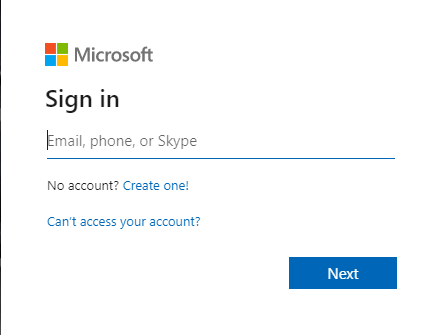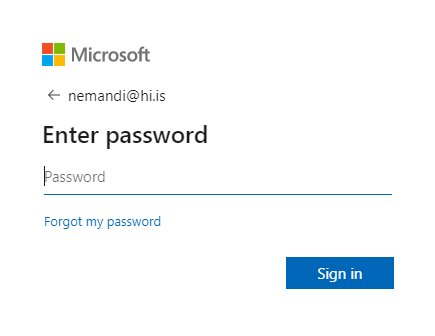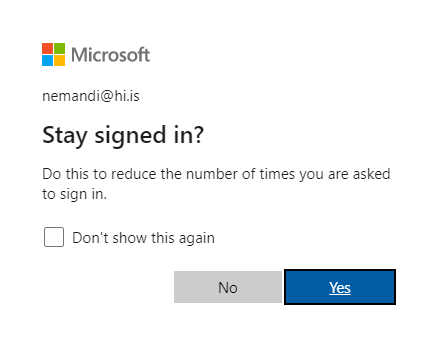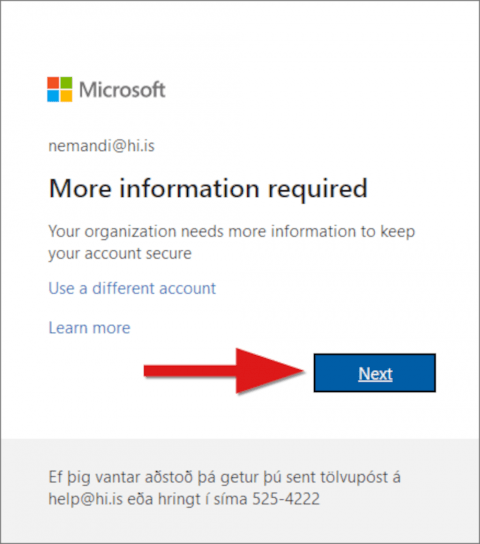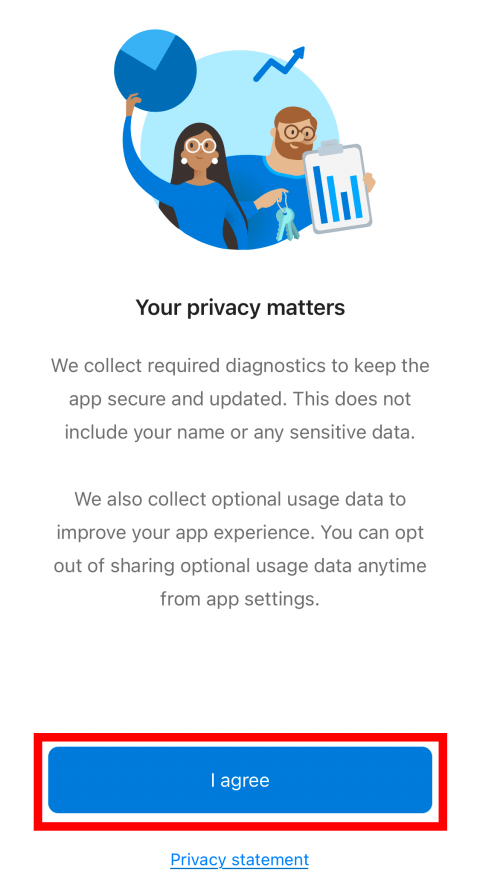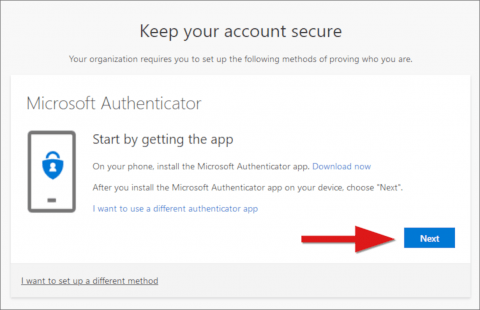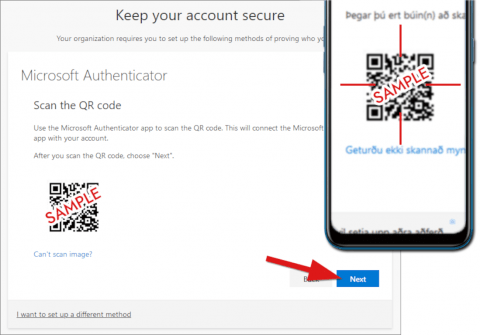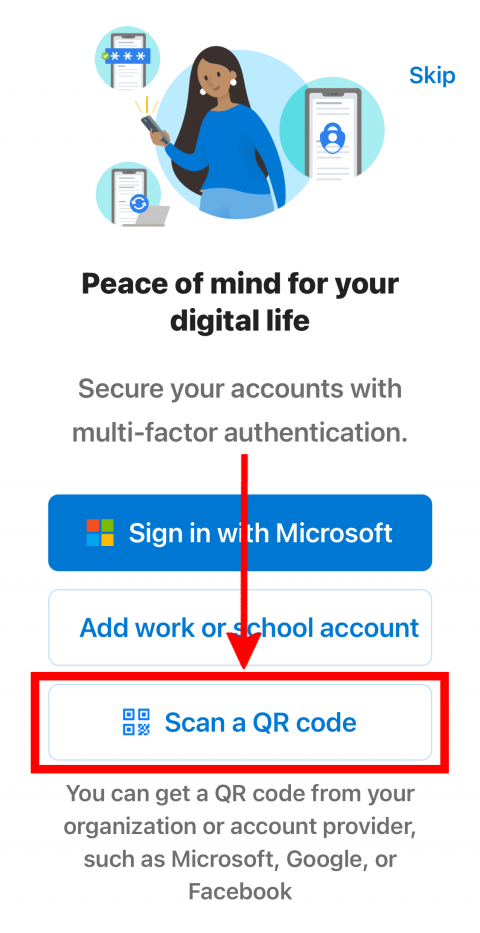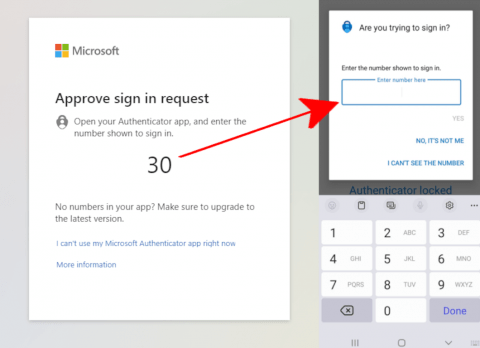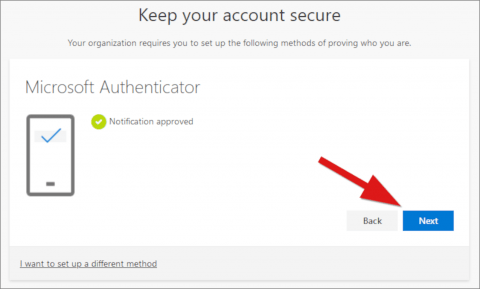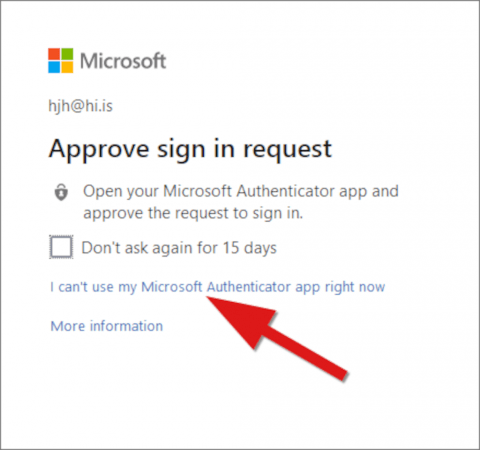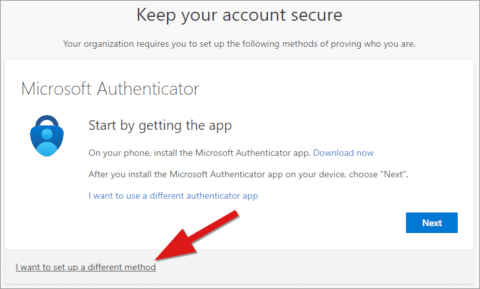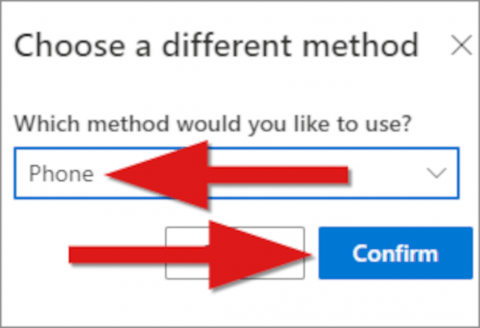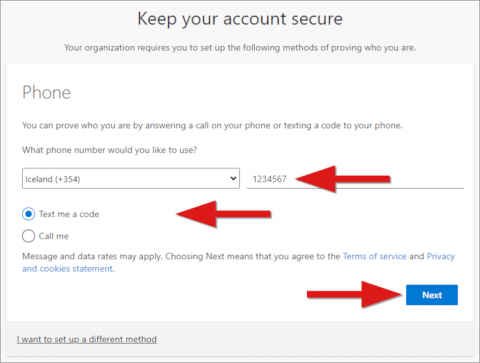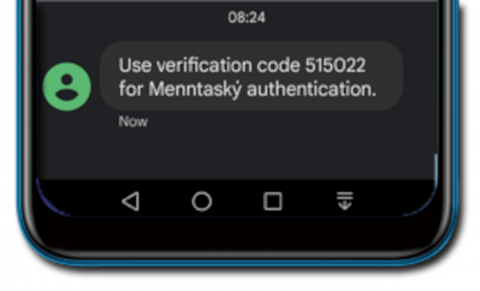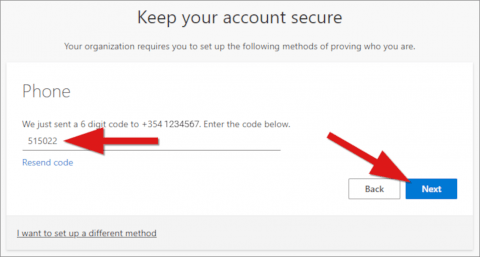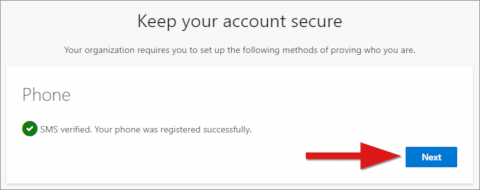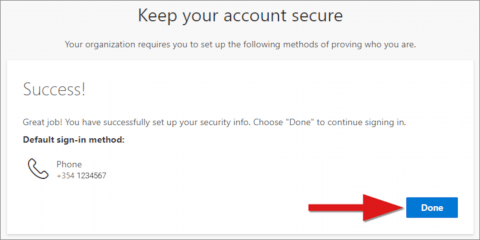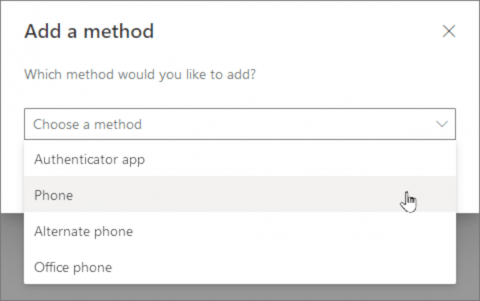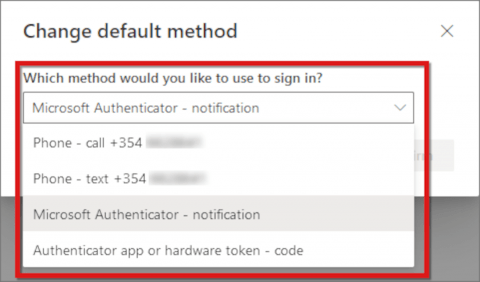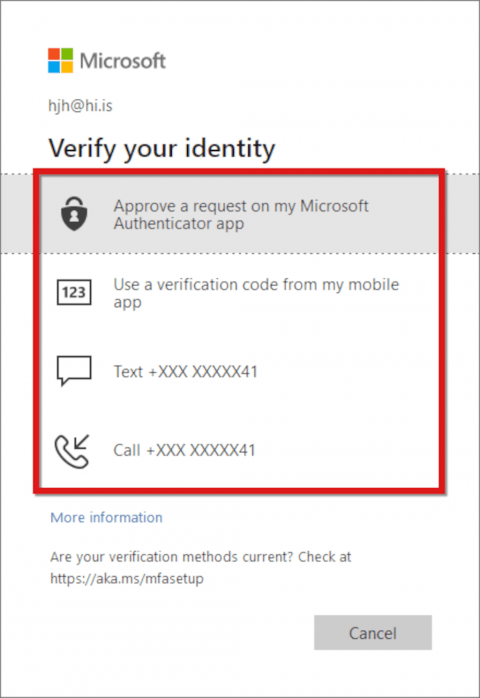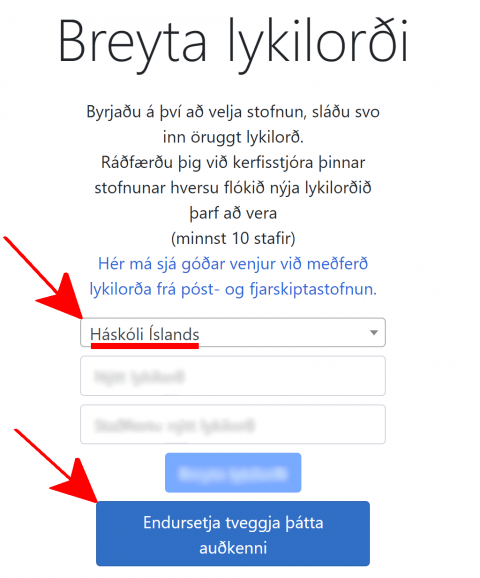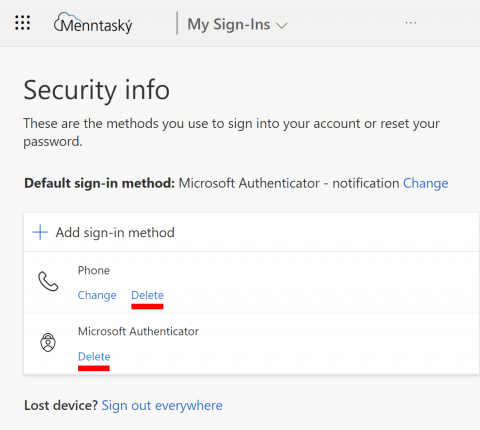Multi-factor authentication
Multi-factor authentication contributes to increased security for all students and employees of the University of Iceland.
The authentication is similar to electronic IDs (electronic certificates) and sends a notification to your phone to confirm login. Users do not have to confirm login when they are connected to the University network.
When switching between phones or getting a new phone number (depending on which authentication method is being used) the authentication method will stop working unless it is reset or transfered to the new device or phone number.
Bellow you will find instructions on how to set up multi-factor authentication.
- Go to mfa.hi.is. NOTE that it is best to do this on a device other than the phone you are using for the two-factor authentication.
- Type in your email address and click "Next":
- Type in your password and click "Sign in":
- If you are using your own device, it is a good idea to click "Yes" here. If, on the other hand, you are on a public computer, it is better to click "No" here:
- Here click "Next":
- When the image below appears on the screen, open your phone, download and install Microsoft Authenticator.
Do not click "Next" until you have installed Microsoft Authenticator:
- You can download the Microsoft Authenticator from App Store (iPhone & iPad) or Google Play (Android). You can not use other authentication apps since Microsoft blocked it.
- Open Microsoft Authenticator on your phone:
- When you open Microsoft Authenticator on your phone for the first time, click "I agree". Allow notifications from the app if you are prompted:
- Now click "Next":
- Click on "Next" again when this window appears:
- Now you will see a QR code. Now you open the Microsoft Authenticator app on your phone, select "Scan a QR code". Select "Work or school" if you are prompted to do so:
- Select "Scan a QR code". Select "Work or school" if you are prompted to do so:
- Your phone may now request access to the camera. Give permission and align the QR code in the middle of the screen to scan it. Then click "Next":
- On your phone you will see a window or a notification asking you to approve the sign-in. Enter the two digit number into the window and select "YES":
- Notification approved. Click "Next":
Now everything should be ready for multi-factor authentication sign-in. You should not have to repeat the steps above until you get a new phone.
From now on every time you sign in to UI's pages or systems and are outside the UI network, you are asked to accept the login on the phone.
You can also confirm your sign in by selecting "Use a verification code" at sign in and use the code found in the Microsoft authenticator app by pressing on your account. If you have set up a default authentication method then you first need to click on "I can't use my [default method shows here] right now".
- Go to mfa.hi.is. NOTE that it is best to do this on a device other than the phone you are using for the multi-factor authentication.
- Type in your email address and click "Next":
- Type in your password and click "Sign in":
- If you are using your own device, it is a good idea to click "Yes" here. If, on the other hand, you are on a public computer, it is better to click "No" here:
- Here click "Next":
- Click on "I want to set up a different method":
- Choose "Phone" from the drop down menu:
- Here you select the country of the number and you type in your phone number. Choose "Text me a code" and click "Next":
- You will receive a code as a text message to your phone (SMS):
- Insert the code you received to your phone. Then click "Next":
- Now you should see a message telling you that your phone was registered. Click "Next":
- Everything should now be ready for multi-factor authentication using a SMS service. Click "Done":
Now every time you log in to UI's pages or systems and are outside the UI network, you are asked to accept the login with a code that you receive as a text message on your phone.
- When you have entered a page where you need UI authentication and are not on the university network, you need to use multi-factor authentication. This is an example showing the authentication process when logging into ugla.hi.is. Start by clicking on "Login":
- Type in your email address and click "Next":
- Type in your password and click "Sign in":
- If you are using your own device, it is a good idea to click "Yes" here. If, on the other hand, you are on a public computer, it is better to click "No" here:
- Now its time to authenticate with the Authenticator app. On your phone you will see a window or a notification asking you to approve the sign-in. Enter the two digit number into the window and select "YES":
- You may now be asked for face ID, fingerprint or PIN:
- When this is done, you should be signed in to the site/system you were logging in to.
- Go to mfa.hi.is and sign in (You might need to authenticate).
- Click "Security Info" and select "Add method":
- Here you select the method you want to add. NOTE that you can have more than one phone number and more than one authentication app as a method. There is no limit to how many methods you can set up:
- Once you have followed the steps that follow, which vary depending on which method you add, you can decide which method should be the default.
- Go to mfa.hi.is and sign-in.
- Click "Security Info" and click "Change" for select "Add method":
- Here you choose which method you want to use as the default method. Then click on "Confirm":
- Type in your email address and click "Next":
- Type in your password and click "Sign in":
- If you are using your own device, it is a good idea to click "Yes" here. If, on the other hand, you are on a public computer, it is better to click "No" here:
- Click here "I can't use my... [default method shows here]":
- Select the method you want to use instead of the default grayed-out method:
- You should then receive an SMS, call or approve request in the authentication app, depending on what you select above.
Transfer or reset multi-factor authentication
You can use electronic-ID (Ísland.is) to reset your multi-factor authentication.
- Sign in with electronic-ID through lykilord.menntasky.is
- Select "Háskóli íslands" under "Velja stofnun" and then click on "Endursetja tveggja þátta auðkenni"
- You should now be able to setup multi-factor authentication again using the instructions on this page.
If you have access to your old phone, phone number or have set up more than one authentication method then you can transfer the authentication method to another phone or phonenumber.
- Sign into mfa.hi.is with your university email address, if you want to use a different authentication method select "I can't use my... [default method shows here]" and finish signing in.
- Now you will see all of your authentication methods and are able to delete the old one's.
- Select "Add sign in method" and setup your authentication method again. Instructions are here above.
If you do not have electronic-ID then bring a passport or a drivers licence to the IT help desk in the University Center (Háskólatorg).
Common issues
Your multi-factor authentication will stop working if you:
- Change phones.
- Delete the Microsoft Authenticator app.
- Remove the account from the Microsoft Authenticator app.
- Get a new phone number.
- Turn off the notifications for the Microsoft Authenticator. You can turn them back on.
If that happens then you will need to reset your multi-factor authentication. Instructions are here above.
Unfortunately it can be difficult to receive text messages through Icelandic phone numbers while abroad. We therefore recommend using the Authenticator app instead.
If you use the Microsoft authenticator app and have bad reception or don't wan't to pay for mobile data then you can also select "Use a verification code" at sign in and use the code found in the Microsoft authenticator app by pressing on your account. If you have set up a default authentication method then you first need to click on "I can't use my [default method shows here] right now".
Here are other ways to get back into your account:
- If you have setup more then one authentication method then select "I can't use my [default authentication method] right now" and you will be able to use your other method.
- You can reset your multi-factor authentication. Instructions are here above.
- Connect to the schools network using our VPN. Please note that hotels often block the use of VPN services on their networks.
If you use the Microsoft authenticator app and have bad reception then you can also select "Use a verification code" at sign in and use the code found in the Microsoft authenticator app by pressing on your account. If you have set up a default authentication method then you first need to click on "I can't use my [default method shows here] right now".

